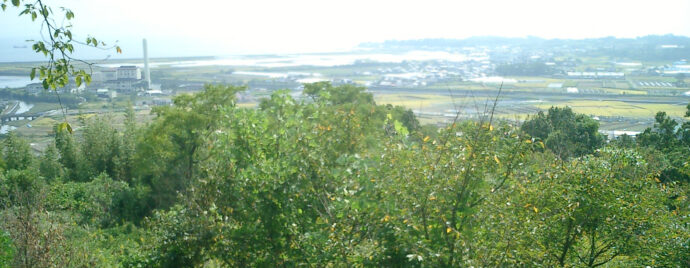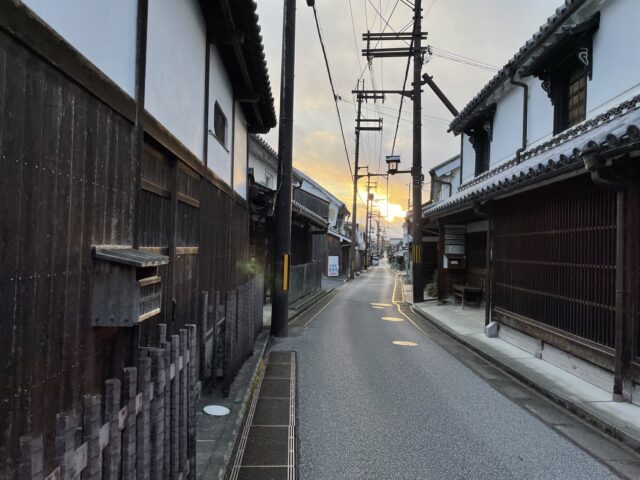2024.02.05
Commemorating the 400th Anniversary of Shimabara Castle Construction: The Story of Shigemasa Matsukura, the Lord of Shimabara Castle -San
The Castle of Kaido – Biography of Shigemasa Matsukura
Yoshiyuki Amatsu

-SAN-
This is no good.”
Looking down at the map of the Hinoe*1 area, Shigemasa cut him off with a single word.
This castle, is it?”
Shinbei Okamoto, a close aide, asked, already sitting up, his eyes fixed on the castle from the window. From Hinoe Castle, built on a hillside near the mouth of the Arima River, he could see the sea, the sky, and even the islands of Amakusa in the far distance. The coastline appears shiny and wet because the tide has largely receded, creating mud flats. To the south was Hara Castle, a branch castle built by the old Arima clan, but Shigemasa could see nothing more than a disappointed gasp.
He could see a branch castle built by the old Arima clan to the south. No matter how they try to dress it up, it is a mountain castle with old roots. It is hard to live in and is no match for us.
Hinoe Castle was originally a mountain castle built in the Kamakura period (1185-1333). It was the residence of the Arima clan for many generations, and the present castle was a magnificent structure that incorporated the Kinai. Kinai castle construction techniques that Harunobu Arima learned under the Toyotomi regime. The castle is located on a hillside between the Arima River to the south and the Ote River to the east.
The castle is set on a hill between the Arima River to the south and the Otesugawa River to the east, with the main, second, and third castle towers built on the steep slopes.
The steep slope of the terrain is very steep. It may be good for war preparations, but there will be no more wars.
The Hara Castle, which Shigemasa was looking at, was also a sea castle built in the Muromachi period (1336-1573) and renovated by Harunobu. Surrounded by cliffs to the north, east, and south, and with a salt beach spreading out beneath the cliffs on the west side, it was a strategic location.
(What is needed from now on is not a castle prepared for war, but a castle suitable for the age of politics.)
Shigemasa was convinced of this because he had fought through the battle of Osaka. The late Tokugawa Ieyasu, the great lord of the Tokugawa shogunate, punished Toyotomi and his patrons at every turn during the Battle of Osaka, and then issued the Laws of the Warring States and the “One Castle per Province” ordinance, thereby thoroughly squashing any chance of war. This was no longer an era in which warfare was the only way to gain supremacy, but an era in which political success was the only way to gain power under the rule of the Tokugawa shogunate. In this sense, castles that were merely strong were useless.
What was needed was a castle that would serve as a convenient center of territorial management and a symbol of one’s own reign. In this sense, Hinoe Castle, which stood on a steep mountain, was difficult to use.
“Shinbei, look at this. Shinmachi is a dream come true if it is this small.”

The biggest problem for Shigemasa was that the castle was so small that there was no way to build a new castle town.
Shigemasa entered Hinoe Castle in July, took over the administration of the castle from the shogunate, and immediately began preparing for the inspection of the land. He also set out on a tour of the fiefdom and made plans to visit the area with his own eyes.
The assessed land value of various domains is based on land surveys conducted at the beginning of the Keicho era, but this represents the surface value… It’s what’s recorded in the account books, and there’s often a significant gap between this and the actual yield, known as “uchi-takau,” or the inner yield. Furthermore, the assessed land value primarily accounts for cultivated fields, often neglecting products from mountains or seas, as well as profits from trade. To verify these personally and to make themselves known to the people of the domain, lords would conduct inspections, aiming to achieve both land surveys and patrols.
First, Shigemasa, who had become the lord of Hinoe Castle, inspected the surroundings of the administrative center. However, he quickly noticed not only the castle itself but also the challenges of this region.
Shigemasa, who had become the lord of Hinoe Castle, first inspected the surroundings of the administrative center. However, he quickly noticed not only the castle itself but also the challenges of this region.
“Well, indeed. With the sea and mountains pressing in, there is little room to expand.”
The area around Hinoe Castle is hilly, bordering on the estuary, and is also close to the coast. There is little open flat land, and even that is already filled with samurai residences where his retainers live.
“Furthermore, the Arima River is known for its violent floods. People should not gather in places where they might be swept away by the water.”
Then, will you move your headquarters?
Of course. I already have my eye on it.
At the foot of that mountain?
Shinpei smiled slightly as he said this. Shigemasa dared to make a sullen face, but this aide’s smile only deepened.
He was very much attached to that mountain,” said Shigemasa. Surely it must be Mount Kongo*2, Mount Ryumon*2, or Mount Tamu*2.”
He said, “That’s a joke. It’s just that the geographical location is good. If there is another good place, that is fine.
Shigemasa said this, but his heart was already set on Shimabara. It was not just an emotional story, as Shinbei had said. Shigemasa’s mind was haunted by the words left behind by Ieyasu, his great master, who was on his sickbed.
The battle of the last year is still in progress.
Shigemasa’s own understanding of the meaning of these words made him realize that the prosperity of the castle and its surroundings was essential, and that he would definitely like to have a connection with the seaside fortunes.
In any case, I’m throwing away Hinoe and Hara. …… because there are troubles that are unique to this place.
That trouble is coming.
At these words, Shigemasa finally looked at Shinpei squarely.
A red-headed man calling himself Torres requests an audience.

It is no exaggeration to say that Hinoe was the most Christian area in Japan at that time. In 1562, Yoshinao Arima of that time granted permission for Kuchinotsu*3 in the south to be a port of call for Portuguese ships. Since then, the area flourished as a center for trade with the southern barbarians, and at the same time, many missionaries came to Japan, making it the home of the Christian church’s missionary activities in Japan.
Furthermore, under the patronage of Harunobu Arima, the last Christian feudal lord, a seminary and seminaries were established by the Jesuits, and the local people who were indoctrinated there became Christians. In fact, the number of Christians became so large that the destruction of Buddhist temples and persecution of Buddhists was rampant in the area.
However, in 1612, the shogunate issued an edict forbidding the spread of Christianity in the area under its direct jurisdiction and destroyed churches. In fact, Naozumi, a son of Harunobu, suppressed the Christians in his domain, forcing them to convert to Christianity, and the seminaries were also closed.
Because of this, the Westerners who remain in Hinoe are not religious, but are limited to merchants, sailors, and others. In addition, after Ieyasu’s death, the current shogun, Tokugawa Hidetada, issued an ordinance restricting the entry of foreign ships to Nagasaki and Hirado*4, and Westerners other than Dutch and Englishmen were supposed to be expelled to Manila and Macau.
I am very pleased to make your acquaintance, Mr. Matsukura-sama.
The Dutchman, who introduced himself as Torres, greeted me in fluent Japanese.
You are very fluent in Yamato,” he said.
I am very grateful for the compliment. I learned the Japanese language in Manila and came here as a translator.
I see. I see. If you are a red-headed man who is proficient in the Japanese language, you are most likely to be known as a “Bantenren”.
It was not the first time for Shigemasa to see Westerners. The Kinai region, where Yamato Province is located, had seen a large influx of Westerners since the acceptance of Nobunaga Oda, and there was also a seminary in Azuchi, Omi, where Nobunaga had his castle. There was also a seminary in Azuchi, Omi, where Nobunaga had a castle. In Settsu, there was Takayama Ukon, a famous Christian feudal lord, and there were many Western settlements and churches, so Shigemasa was not surprised.
If we find the Bantenren now, we must capture them and exile them abroad.
I am aware of that. The cost of a single ship, even if it only goes as far as Manila, will be enormous. And that is just to transport one or two people.
At Torres’s remark, Shigemasa narrowed his eyes slightly and gazed at the chiseled face of the Dutch merchant. He looked at the pale face, which did not look like a merchant’s face.
Having spent many years in Yamato dealing with the Buddhist powers in the southern capital, Shigemasa was familiar with that kind of face. They are the faces of those who are deeply religious and who have placed themselves in the sect Shumon …… religious people. They are ordained and outside the confines of the secular world, but they still desire to have a stake in the secular world. It was obvious that this Torres was a member of the Christian sect, as well as the intention of this meeting.
It was not worth it to actively seek out and expel the Bantenren hiding in Hinoe. He came to Shigemasa to say so.
He said to Shigemasa, “You are right. I have just entered this land, and I do not want to waste the resources to start a new government. If we are going to sail, we might as well trade and make a profit.
Shigemasa read the Dutchman’s intentions correctly and turned to him. Shigemasa had no intention of suppressing the Christians. Based on his experience in Yamato, it was better for him to keep a moderate distance with the sect, and to occasionally lend and borrow from each other.
Of course, we cannot outwardly defy the Shogunate’s edict against the faith. However, there were always two sides to every story. And the Dutchman, who had learned about Japan, seemed to know this.
If so, please leave it to me. Fortunately, I have business associates in Takasago, Macau, Konohaguchi, Manila, and other places. If you wish to trade with these places, I promise to arrange a meeting with them.
In return, Torres did not say anything, and Shigemasa did not pursue the matter. It goes without saying, but that is the way of the world.
Torres’ offer was a godsend to Shigemasa.
It is a well-known fact that the Arima clan, a small feudal lord in Takarai, Hizen, had been able to penetrate deeply into the Toyotomi administration because of the wealth they had amassed through trade with the southern barbarians. And for Shigemasa, who was about to embark on a new political career, this wealth was also a necessity. In fact, Shigemasa had already applied to the shogunate for permission to travel abroad, following in Arima’s footsteps.
Shigemasa had already applied to the shogunate for a red seal, which would allow him to travel abroad, succeeding Arima’s letter. Therefore, tell your companions to wait for that time.
Shigemasa looked into Torres’s green eyes as if to say something more than what he meant.
I will, sir. My friends will be pleased.
As he said this, Torres clasped his hands together in prayer. Shigemasa accepted the hand gesture, which was similar to, but distinctly different from, a Buddhist gesture.
【Notes】
*1 Hinoe: Around present-day Kita-arima-cho, Minami-shimabara City.
*2 Kongo, Ryumon-dake, and Tabu-mine: All mountains in Yamato Province (present-day Nara Prefecture), where Shigemasa’s former domain, Yamato Futami, is located.
*3 Kuchinotsu: Currently in Minamishimabara City. 3Kuchinotsu・・・・About 13 km south of Hinoe Castle.
*4 Hirato: Around the present Hirado City, Nagasaki Prefecture.